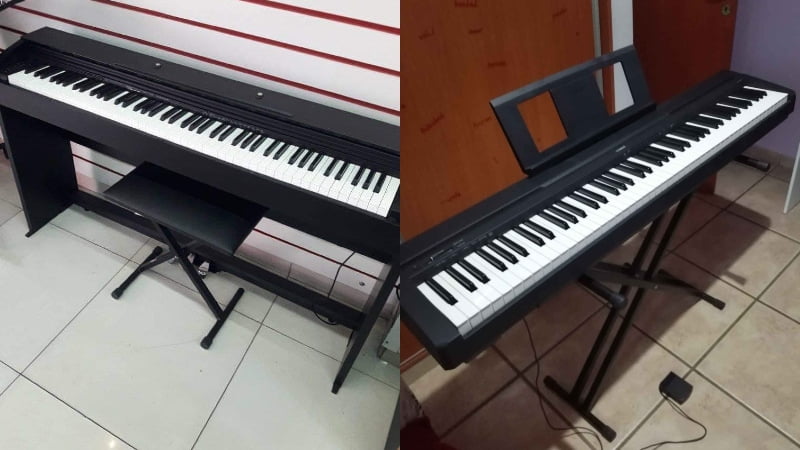If you’re a beginner pianist on the hunt for your first instrument, there’s a high chance you’ve stumbled across the Yamaha P45 and the Casio PX 770. Both are some of the most affordable pianos out there, with the Yamaha P-45 being a portable digital piano and the Casio PX-770 being a console digital piano.
Each of them comes with its own set of benefits, features, and downsides. And after diving into both models in this Yamaha P45 vs Casio PX 770 comparison, I had to dub the Casio PX-770 the winner. The Casio model features richer tones, a wider sound library, and better feel which is why it’s a great investment for any beginner pianist.
However, the Yamaha P-45 is still a great option. It’s portable, comes with all the features you need as a beginner, and is much more affordable than the Casio PX-770. And for a clearer picture, we take a close look at both of these models in this Yamaha P-45 vs Casio PX-770 review.
Yamaha P45 vs Casio PX 770: Comparison Chart




Last update on 2025-04-11 / Affiliate links / Images from Amazon Product Advertising API
Yamaha P45 vs Casio PX 770: The Differences
After an in-depth comparison of the features of both pianos, the final score was 3-1 in favor of the PX-770. While the scores favored the Casio model, I found that the Yamaha P-45 was very close behind in all categories and hosts a wide range of benefits that would make it an ideal piano for beginners. But because of the additional features on the Casio model, I had to declare it the overall winner.
Portability
The winner: Yamaha P-45
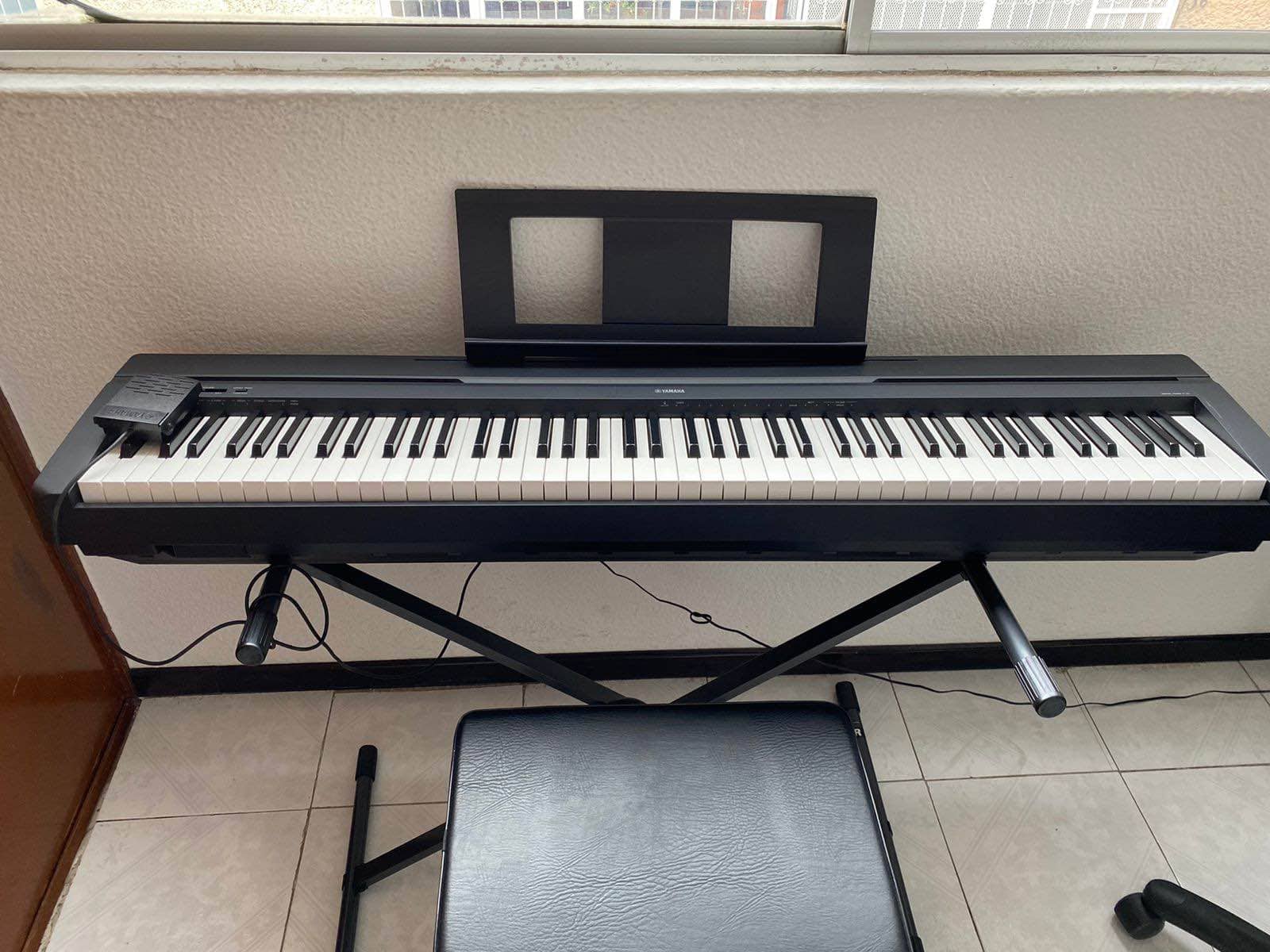
The one area where the Yamaha P-45 was the clear winner was in terms of portability. Remember, these are two different types of pianos. The P-45 is a portable digital piano. So, it’s much lighter, easy to carry, and designed to be moved around. If you plan on bringing a piano with you for performances, piano lessons, and jam sessions with friends, the Yamaha P-45 is without a doubt the best pick for you.
On the other hand, the Casio PX-770 is a console digital piano. These instruments are designed to stay in one place, making them ideal for performance venues and home piano use. If you plan on setting the piano up and keeping it in the same spot for a long time, the PX-770 is a great option. However, when it comes time to move the piano to another location, you can expect a pretty arduous and tough process.
Tone
The winner: Casio PX-770
Don’t get me wrong, the Yamaha P-45 has some of the best tone in its price range. In fact, I was honestly very surprised at how it was able to hold its own against the Casio PX-770. However, when conducting an ear test, it was undeniable that the Casio PX-770 boasted richer, more accurate, and warmer piano tones than the Yamaha model. On top of that, it comes with a more varied selection of different voices, which is why it was the easy winner in this comparison.
+ Tone Generation
The Casio PX-770 uses the AiR tone generator, which is a Casio innovation. On the flip side, the Yamaha P-45 uses the AWM Sampling method, which was pioneered by Yamaha. Both of these methods work under the same principle: sampling. Neither of these pianos contain a robust modeling software to replicate the sound of different instruments. Instead, whenever you press a key on either of these pianos, the instrument plays a sample, which is what you hear from the speakers.
So, the quality of the tone of these pianos largely depends on the quality of the samples. The advantage Yamaha has in this regard is that they sampled their own Yamaha acoustic pianos, which gave the P-45 very rich and recognizable piano voices. With that said, Casio also made sure to use top-quality samples for their voices, which is why it was hard to tell the difference between the two.
Generally, tone is a very subjective topic. In my ears, the Yamaha P-45 boasted brighter tones while the Casio PX-770 had warmer tones. I personally prefer the warmer tones of the PX-770, but there are a lot of people out there who might enjoy the brightness of the P-45 better.
+ Sound Library
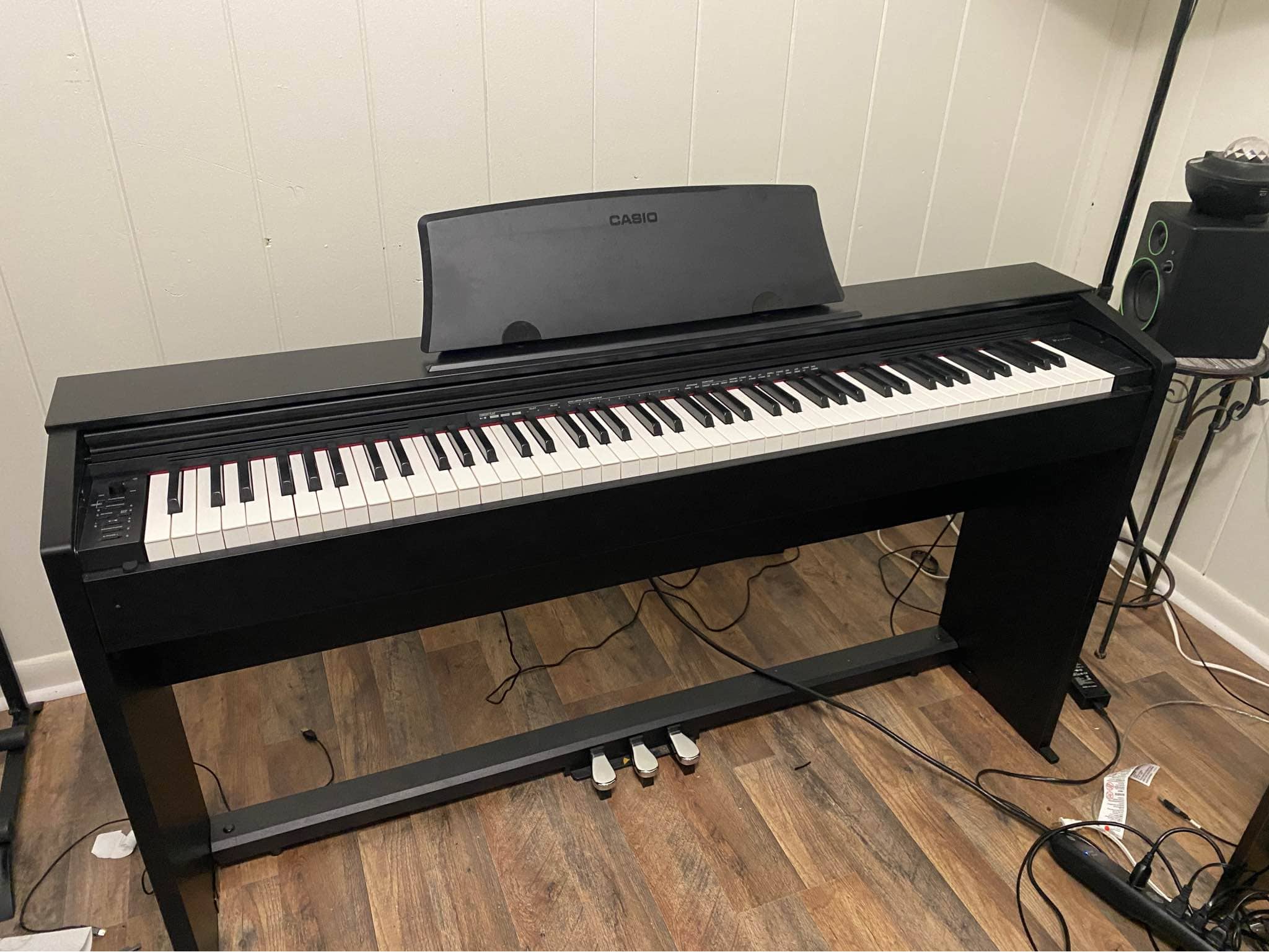
The main reason the PX-770 was the winner when it comes to tone is its sound library. The Yamaha P-45 only comes with 10 voices. Now, if you’re a beginner, this is more than enough. In fact, there’s an argument that it’s better for beginners to have a piano with less voices, as it allows them to really focus on their piano technique and not get distracted by the other tones. So, if you’re only looking to use the piano voices, the Yamaha P-45 is a great pick. On top of that, it also comes with a couple of electric piano, synth, bass, and strings voices.
The Casio PX-770 has 19 voices. This is significantly more than the Yamaha P-45, but most of the voices fall under the same category. So, the main difference with the PX-770 is that you get more choices per category. If you’re a performer or play a variety of genres, this is a great feature as it gives you more versatility and control over the sound of your instrument.
Feel
The winner: Casio PX-770
For its price, the Yamaha P-45 offers great feel. In fact, the GHS hammer action beats out a lot of other models in its price range. However, the Casio PX-770 has a very similar hammer action system and textured keys, which is why it beat out the Yamaha P-45.
+ Hammer Action
GHS stands for “graded hammer system”. This was a system originally developed for Yamaha digital pianos and mimics the heavier action on the left side that gets progressively lighter as you go up. The Casio model uses a similar model, so with either piano you’ll be getting some sort of scaled hammer action to resemble an acoustic piano. Both of these pianos have decent action, especially for its price. And if I was only comparing the hammer action, these two will definitely be tied.
However, you’ll quickly see why the Casio PX-770 wins out in terms of feel and playability.
+ Key Texture
In terms of key texture, the Yamaha P-45 was slightly disappointing. Since it’s one of the more affordable models out there, you will have to make some sacrifices, especially when it comes to key texture. With the Yamaha P-45, you have glossy plastic keys. This is about what is expected in its price range, and while it doesn’t make that big of a difference, experienced pianists will instantly recognize that they aren’t playing on real wooden keys.
The Casio PX-770 also features plastic keys, but they are coated to mimic the feel of ebony and ivory keys. And when playing the instrument, you can really feel the differences. Granted, the Casio PX-770 doesn’t perfectly replicate the texture of wooden piano keys, but it definitely comes much closer than the Yamaha P-45.
Piano features
The winner: Casio PX-770
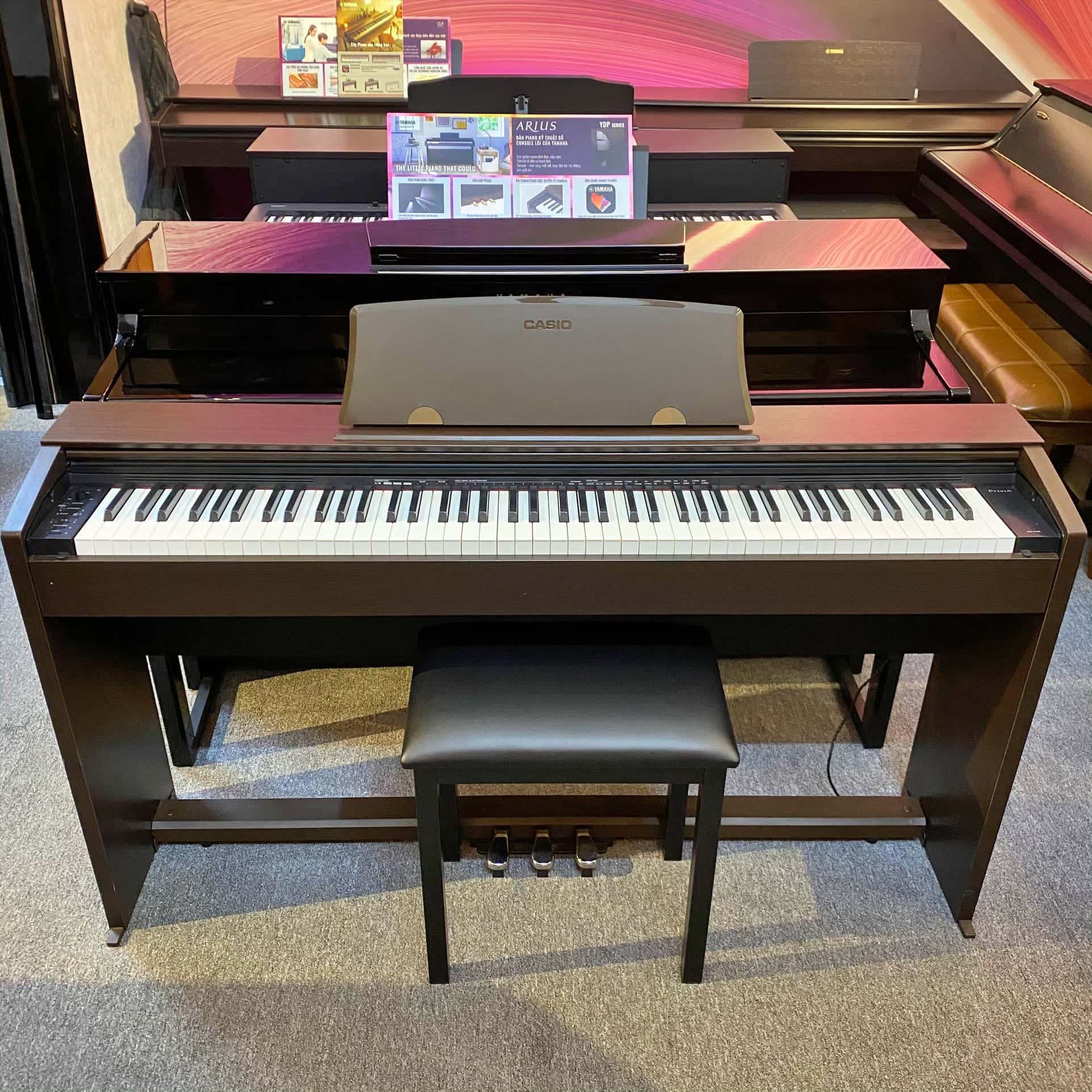
Another area where the Casio PX-770 won out is in terms of piano features. Granted, the Yamaha P-45 actually comes with a range of different features that would benefit any beginner pianist. However, the more expensive PX-770 comes with way more cool piano features that can make learning the instrument much more convenient.
+ Playing Modes
It may come as a surprise, but the Yamaha P-45 has a couple of extra playing modes that beat out the Casio model. However, since this is the only area where the Yamaha P-45 won, the Casio PX-770 is still the overall better option when it comes to piano features.
Both of these pianos come with duo mode. This mode has different names such as duet or lesson mode, which can be confusing when trying out different pianos. However, the function remains the same. With this mode, you can divide the piano into two mini keyboards with the exact same timbre and tuning. The advantage of this mode is that you can play piano duets without crossing over or have teachers properly demonstrate different techniques and pieces without having to use two different keyboards.
However, the Yamaha P-45 comes with an extra playing mode that beats out the Casio. This is called layering mode. With this mode, you can load two voices simultaneously and create a unique sound. This is a great way to experiment with the piano and really discover the instrument.
One advantage of the Casio, however, is that it also comes with recording mode. Now, the recordings won’t be good enough to use in a song, however they are good enough to listen to and judge your playing. That way, you can note down areas that need improvement and areas where you excel.
+ Polyphony
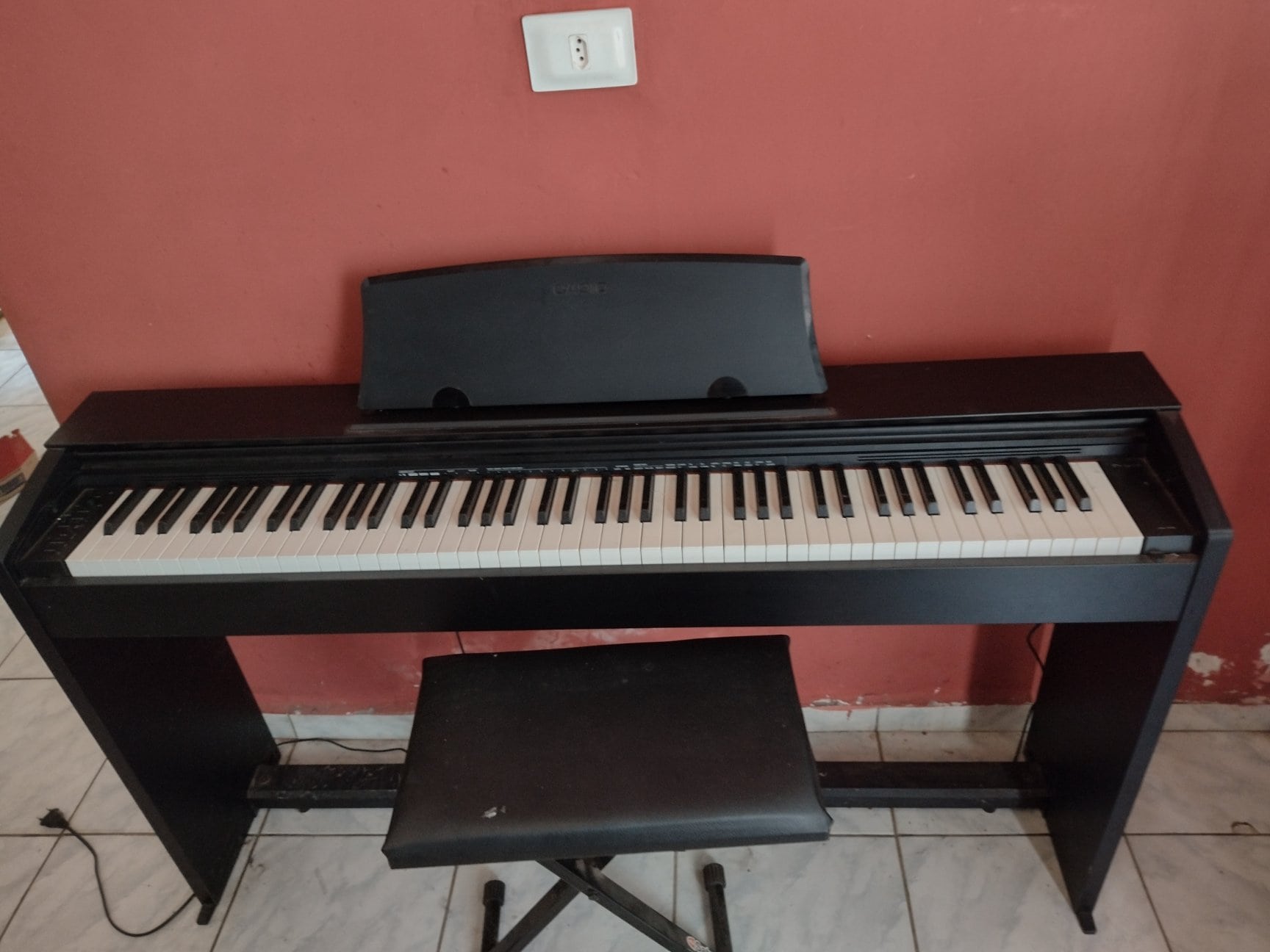
The Casio PX-770 knocks the P-45 out of the park in terms of polyphony. This model features double the polyphony of the Yamaha P-45. The Casio model has a max polyphony of 128, which is significantly greater than the Yamaha’s 64-note maximum polyphony. Now, both pianos can easily handle just about any beginners and even novice music piece out there. However, the Casio PX-770 simply gives more versatility, which is why it was the winner in this regard.
+ Effects
The Yamaha P-45 comes with a reverb effect, which is all you’ll really need when starting out. However, the Casio PX-770 comes with reverb, chorus, and brilliance effects. Now, if you’re a beginner, you’ll probably only need the reverb, but it’s nice to know that there are other cool effects to use when you need them.
+ Connectivity
The Yamaha P-45 doesn’t have MIDI connectivity, which is a major let down. On the other hand, the Casio PX-770 does come with MIDI connectivity, which means you can use it for different piano learning apps and to control virtual instruments on your computer. MIDI connectivity is a huge deal in the modern music scene, which makes the Casio PX-770 the more versatile option overall.
Yamaha P45 vs Casio PX 770: The Similarities
These are two very different pianos. The Yamaha is a portable model while the PX-770 is a console digital piano, which means you won’t find too many similarities between the two. However, that doesn’t mean that there are no similarities between these two instruments.
They both feature full 88-key keyboards, scaled hammer action, and a variety of cool beginner’s features. The most prominent similarities between these two pianos is that they are designed for beginners. These instruments aren’t as sophisticated as the ones made for professionals, but they do a great job for beginner and novice piano. In fact, even advanced students will benefit from either of these instruments.
But since the Casio model is more expensive, it does come with a couple extra features here and there. On the other hand, the Yamah P-45 is more affordable and still comes with great features, making them the ideal piano for beginner pianists shopping on a tight budget.
Quick Rundown of the Casio PX 770
- 88 scaled, weighted hammer-action keys with simulated ebony and ivory textures
- Stunning new piano sound with detailed resonance, plus 18 other Tones
- Stereo speaker system built into stylish, modern wooden cabinet
- Versatile practice, performance, and MIDI recording tools
- 3 year manufacturer extended warranty
Last update on 2025-04-11 / Affiliate links / Images from Amazon Product Advertising API
Quick Rundown of the Yamaha P45
- Includes the P45 Digital Piano, power adapter, sustain pedal and music rest
- 88 fully weighted piano style keys simulate the feel of an acoustic piano and provide a quality playing experience
- GHS weighted action is heavier in the low end and lighter in the high end, just like an acoustic piano
- Contains 10 different voices, including digitally sampled tones from real Yamaha acoustic grand pianos
- Dual mode lets you combine 2 voices together, like piano and strings, for an inspiring new playing experience. Tuning- 414.8 - 440.0 - 446.8 Hz
Last update on 2025-04-12 / Affiliate links / Images from Amazon Product Advertising API
Product Videos
Related Articles to Casio Px 770
- Casio PX-770 vs Korg B2SP: A Battle of Budget Console Digital Pianos?
- Casio PX-770 vs Kawai KDP-110: The Best Console Digital Pianos on a Budget?
- Casio PX-770 vs Kawai ES-110: Should You Get A Portable or Console Digital Piano?
- Casio PX-770 vs PX-160: Should You Get A Portable or Console Digital Piano?
- Casio PX-770 vs S1000: Should You Get A Portable or Console Digital Piano?
- Casio PX-770 vs 750: Finding the Best Budget Digital Piano
- Casio PX-770 vs PX-860: Should You Get A Portable or Console Digital Piano?
- Casio PX-770 Vs AP-270: Which Casio Model Wins Out?
- Casio PX-770 Vs 760: Which Is The Better Casio Privia Model?
- Casio PX-770 Vs Yamaha DGX-660: Should You Get A Portable Or Console Digital Piano?
- Casio PX-770 Vs Yamaha YDP-143: Which Is The Better Piano For The Money?
- Casio PX-770 Vs Roland FP-30: Should You Get A Portable or Console Digital Piano?
- Casio PX-770 vs Yamaha YDP-144: Which Is The Better Digital Piano?
- Casio PX-770 Vs 780: What’s The Difference Between These Two Digital Pianos?
- Casio PX-770 Vs 870: Which Casio Console Digital Piano Is Better?
- Yamaha P125 vs Casio PX-770 Review: Why the Yamaha P125 Beats Out the Casio Console Digital Piano
Related Articles to Yamaha P45
- Yamaha P45 vs P45B: What’s the Real Difference?
- Yamaha P45 vs DGX-650: Is the DGX-650 Worth the Higher Price?
- Yamaha P-35B vs P45: Finding the Best Affordable Yamaha Piano
- Yamaha P45 Vs DGX-660: A Head-to-Head Comparison
- Yamaha P45 vs Williams Rhapsody II: A Head-to-Head Comparison
- Yamaha P45 Vs NP32: A Head-to-Head Comparison
- Yamaha P45 vs Williams Allegro III: Finding the Best Digital Piano on a Budget
- Yamaha P45 vs YPG 535: Which Is the Best Affordable Yamaha Piano?
- Yamaha P60 vs P45: Finding the Best Yamaha Portable Digital Piano
- Yamaha P45 vs P105: Should You Spend Extra for the P105?
- Alesis Recital Vs Yamaha P45: Which Offers Great Value For Money?
- Donner DEP-10 Vs Yamaha P-45: Which Digital Piano Is Better?
- Yamaha P45 Vs Korg B2: Which Digital Piano Fits Beginners Better?
- Yamaha P45 VS P115: Which P-Series Newbie Gives You More Value for Money?
- Yamaha P45 vs Casio CDP S100: Finding the Better Bet for Beginners
- Yamaha P45 vs YDP 103: Should You Get a Portable or Console Digital Piano?
- Alesis Recital Pro vs Yamaha P45: Which Should You Get As Your First Piano?
- Yamaha P45 vs Roland FP10: Which Entry Level Titan Takes the Top Spot?
- Yamaha P45 vs Donner DEP 20: Which Model Is the Better Option for Beginners?
- Alesis Prestige Artist vs Yamaha P45: Can Alesis Hold Its Own Against the Popular Yamaha Model?
- Yamaha P45 vs P125: Why the Yamaha P125 Is the Better Pick for Pianists
- Yamaha P71 vs P45: Why the Amazon Exclusive P71 is the Better Digital Piano
References:
- Casio Privia PX-770 – Black Finish: https://www.sweetwater.com/store/detail/PX770BK–casio-privia-px-770-black-finish
- Yamaha P-45 88-key Digital Piano with Speakers: https://www.sweetwater.com/store/detail/P45BK–yamaha-p-45-digital-piano
Lulacruza is an electronic folk duo operating at the junction of the hypermodern and the ancient. Our music weaves together hypnotic female singing, South American folk instruments and electronic processing, while channeling pulsating waves from the source of creation.
Lalucruza is also a community where you can connect with other music lovers to collaborate, exchange ideas and share knowledge. A platform for who wants to learns the basics of playing piano, guitar, drum masters’ technique, etc.. is the premise of our website.
